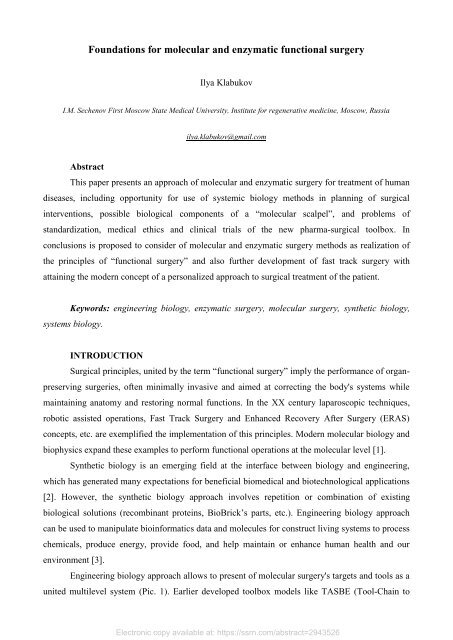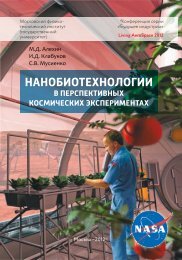Foundations for Molecular and Enzymatic Functional Surgery
This paper presents an approach of molecular and enzymatic surgery for treatment of human diseases, including opportunity for use of systemic biology methods in planning of surgical interventions, possible biological components of a “molecular scalpel”, and problems of standardization, medical ethics and clinical trials of the new pharma-surgical toolbox. In conclusions is proposed to consider of molecular and enzymatic surgery methods as realization of the principles of “functional surgery” and also further development of fast track surgery with attaining the modern concept of a personalized approach to surgical treatment of the patient.
This paper presents an approach of molecular and enzymatic surgery for treatment of human diseases, including opportunity for use of systemic biology methods in planning of surgical interventions, possible biological components of a “molecular scalpel”, and problems of standardization, medical ethics and clinical trials of the new pharma-surgical toolbox. In conclusions is proposed to consider of molecular and enzymatic surgery methods as realization of the principles of “functional surgery” and also further development of fast track surgery with attaining the modern concept of a personalized approach to surgical treatment of the patient.
Create successful ePaper yourself
Turn your PDF publications into a flip-book with our unique Google optimized e-Paper software.
<strong>Foundations</strong> <strong>for</strong> molecular <strong>and</strong> enzymatic functional surgery<br />
Ilya Klabukov<br />
I.M. Sechenov First Moscow State Medical University, Institute <strong>for</strong> regenerative medicine, Moscow, Russia<br />
ilya.klabukov@gmail.com<br />
Abstract<br />
This paper presents an approach of molecular <strong>and</strong> enzymatic surgery <strong>for</strong> treatment of human<br />
diseases, including opportunity <strong>for</strong> use of systemic biology methods in planning of surgical<br />
interventions, possible biological components of a “molecular scalpel”, <strong>and</strong> problems of<br />
st<strong>and</strong>ardization, medical ethics <strong>and</strong> clinical trials of the new pharma-surgical toolbox. In<br />
conclusions is proposed to consider of molecular <strong>and</strong> enzymatic surgery methods as realization of<br />
the principles of “functional surgery” <strong>and</strong> also further development of fast track surgery with<br />
attaining the modern concept of a personalized approach to surgical treatment of the patient.<br />
Keywords: engineering biology, enzymatic surgery, molecular surgery, synthetic biology,<br />
systems biology.<br />
INTRODUCTION<br />
Surgical principles, united by the term “functional surgery” imply the per<strong>for</strong>mance of organpreserving<br />
surgeries, often minimally invasive <strong>and</strong> aimed at correcting the body's systems while<br />
maintaining anatomy <strong>and</strong> restoring normal functions. In the XX century laparoscopic techniques,<br />
robotic assisted operations, Fast Track <strong>Surgery</strong> <strong>and</strong> Enhanced Recovery After <strong>Surgery</strong> (ERAS)<br />
concepts, etc. are exemplified the implementation of this principles. Modern molecular biology <strong>and</strong><br />
biophysics exp<strong>and</strong> these examples to per<strong>for</strong>m functional operations at the molecular level [1].<br />
Synthetic biology is an emerging field at the interface between biology <strong>and</strong> engineering,<br />
which has generated many expectations <strong>for</strong> beneficial biomedical <strong>and</strong> biotechnological applications<br />
[2]. However, the synthetic biology approach involves repetition or combination of existing<br />
biological solutions (recombinant proteins, BioBrick’s parts, etc.). Engineering biology approach<br />
can be used to manipulate bioin<strong>for</strong>matics data <strong>and</strong> molecules <strong>for</strong> construct living systems to process<br />
chemicals, produce energy, provide food, <strong>and</strong> help maintain or enhance human health <strong>and</strong> our<br />
environment [3].<br />
Engineering biology approach allows to present of molecular surgery's targets <strong>and</strong> tools as a<br />
united multilevel system (Pic. 1). Earlier developed toolbox models like TASBE (Tool-Chain to<br />
Electronic copy available at: https://ssrn.com/abstract=2943526
Accelerate Synthetic Biological Engineering) [4], ATPG algorithms <strong>for</strong> cancer therapy [5], etc. are<br />
the cornerstone of this approach.<br />
Pic. 1. Multilayer model of molecular interventions in living organisms with engineering tools.<br />
The use an approach of systems <strong>and</strong> synthetic (engineering) biology allows to implement the<br />
advanced bioengineering concepts <strong>for</strong> “synthetic morphogenesis” [6] <strong>and</strong> “organ bud” [7], as well<br />
as toolbox <strong>for</strong> molecular <strong>and</strong> enzymatic surgery.<br />
SURGERY ON MOLECULAR LEVEL<br />
The idea of surgery at the molecular level was first put <strong>for</strong>ward by Nobel laureate Richard<br />
Feynman in 1959 [8] as an example of the potential use of nanoscale mechanisms <strong>for</strong> medical<br />
purposes. Further the concept of interventions at the molecular <strong>and</strong> tissue levels <strong>for</strong> changing the<br />
phenotype of tissues received its instrumental solution in the <strong>for</strong>m of genetic engineering tools.<br />
The term “molecular surgery” was first <strong>for</strong>mulated in 1966 to describe the intervention on<br />
cell activity at the DNA level [9]. Further terminology has gained development in the concept of<br />
systems of genome editing (“surgery of genes”) [10], molecular surgery of cancer [11], etc.<br />
Recently developed genome editing systems (based on CRSPR/Cas9, TALEN, ZFN) <strong>for</strong><br />
therapeutic purposes allow to restore/recreate the normal cellular phenotype <strong>and</strong>, as a consequence,<br />
the normal functionality of pathologically altered tissues. Today the systems of molecular surgery<br />
<strong>for</strong> the treatment of cardiomyopathies, sickle-cell anemia <strong>and</strong> oncological diseases are in clinical<br />
Electronic copy available at: https://ssrn.com/abstract=2943526
studies. The use of these methods <strong>for</strong> therapy of early fatal illness (Table 1) is extremely<br />
progressive.<br />
Table 1. Examples of target diseases <strong>for</strong> molecular surgery therapy.<br />
Disease Target Theoretical mechanism of action<br />
Primary<br />
sclerosing<br />
cholangitis<br />
More than 33 loci<br />
Genetic improvement of genome mutations<br />
in human epithelial cells.<br />
Cystic fibrosis CFTR gene Genetic improvement of CFTR gene in<br />
somatic cells.<br />
Duchenne muscle<br />
dystrophy<br />
Leber's hereditary<br />
optic neuropathy<br />
Gallbladder<br />
diseases<br />
Dystrophin gene<br />
mtDNA mutations<br />
Regulation of cholangiocytes<br />
transcriptomics / biliary<br />
microbiome engineering<br />
Genetic improvement or replacement of<br />
Dystrophin gene in somatic cells.<br />
Genetic improvement of mtDNA mutations.<br />
Correction of secretion functions of<br />
cholangiocytes <strong>and</strong>/or biliary microbiota<br />
interventions.<br />
The use of molecular surgery methods does possible treatment of genetic diseases (genome<br />
level), diseases associated with pathological regulation of genes (transcriptome level), diseases<br />
associated with pathological proteo<strong>for</strong>ms of proteins (proteome level), diseases associated with the<br />
noise in genetic networks (epigenome level) <strong>and</strong> allows <strong>for</strong> interventions in prenatal <strong>and</strong> postnatal<br />
period (incl. adults).<br />
ENZYMATIC SURGERY<br />
Correction of large-scale tissue defects is the goal of another discipline – an “enzymatic<br />
surgery”. The term “enzymatic surgery” was first <strong>for</strong>mulated in 1981 to describe processes of DNA<br />
repair by special enzymes [12], but further the use of this methods has extended on manipulation<br />
with cells <strong>and</strong> tissues <strong>for</strong> example as a new treatment modality <strong>for</strong> burns [13]. Although today<br />
enzymes are mainly used <strong>for</strong> the treatment of digestive diseases, but the use of specific delivery<br />
systems allows <strong>for</strong> large-scale interventions to remodel pathologically altered tissues, <strong>for</strong> example,<br />
by delivering metalloproteinases to destroy proliferating fibrous tissue. The development of the<br />
enzymatic surgery is associated with selection of high-specific delivery vectors (cells, monoclonal<br />
antibodies, single-chain antibodies <strong>and</strong> fragments thereof), but also with the withdrawal <strong>and</strong><br />
deactivation of toxic products <strong>and</strong> their utilization with the patient’s own organs (liver,<br />
gastrointestinal tract, kidneys, lungs, gl<strong>and</strong>s, etc.).
The good example of prototype of enzymatic surgery agent are the nanoparticles with<br />
biocomputing capabilities could potentially be used to create sophisticated autonomous nanodevices<br />
on DNA/RNA-based computing techniques [14].<br />
Table 2. Examples of target diseases <strong>for</strong> enzymatic surgical therapy.<br />
Hepatic<br />
cirrhosis<br />
Disease Target Theoretical mechanism of action<br />
Connective tissue<br />
Local destruction of connective tissue<br />
components in liver.<br />
Retinal<br />
detachment<br />
Retina’s cellular environment<br />
Prevention of retinal detachment by local<br />
inhibition of vessel growth.<br />
Down syndrome Copy of the 21st chromosome Destruction or inactivation of 3nd copy of<br />
the 21st chromosome in all somatic cells<br />
or only stem cells in human body.<br />
Appendicitis Gut microbiota components Suppression of biological activity of<br />
microbiota-induced inflammation factors<br />
(both molecules <strong>and</strong> cells).<br />
A correction of the spatial organization of enzymatic agents in a human body <strong>and</strong> an<br />
adjustment of physiological influence are required an external control facilities using of physical<br />
fields by the operator-surgeon (acoustic impact <strong>and</strong> electromagnetic, laser, infrared radiation, etc.).<br />
It seems advisable to development of an enzymatic toolbox <strong>for</strong> both functional <strong>and</strong> plastic surgery<br />
(proliferation under control of enzymatic agents <strong>and</strong> otherwise).<br />
MOLECULAR TOOLBOX : A NEW PRECISION SCALPEL<br />
The effectiveness <strong>and</strong> specificity of systems of molecular <strong>and</strong> enzymatic surgery are<br />
associated with the improvement of delivery vectors. Highly specific delivery to target tissues can<br />
be carried out through cell-based vectors, viral systems (AAV, HIV, HSV, etc.), RNA-protein<br />
complexes <strong>and</strong> bactofection agents.<br />
The use of gene therapy opportunities has allowed a molecular surgery of cancer diseases<br />
[15] <strong>and</strong> in 1992 the first time are discussed with FDA a permission of virus therapy <strong>for</strong> treatment<br />
of inoperable glial tumors. The reconciliation processes continued until 2015, when the FDA first<br />
approved therapy using oncolytic viruses [16].<br />
Now the concept of toolbox of a “molecular scalpel” can be defined as conjugates with<br />
biological molecules (proteins <strong>and</strong> DNA/RNA con<strong>for</strong>mations), cells, nanoparticles <strong>and</strong> control<br />
loops through physical fields (laser, infrared radiation, sonic waves, etc.) <strong>and</strong> physiological<br />
signaling (cellular environment, transcriptomic <strong>and</strong> metabolomic patterns, peripheral<br />
neurosignaling, etc.) (Pic. 2).
Pic. 2. Toolbox of the “molecular scalpel” components.<br />
With regard to the traumatic nature of large-scale minimally invasive molecular operations,<br />
it can be assumed that recovery processes of this will be faster than in modern Fast Track <strong>Surgery</strong><br />
techniques [17]. The key roles of “surgical team 2.0” will be an bioengineer with an operatorsurgeon<br />
(as well as in robotic assisted operations) [18].<br />
Previously the term “personalized surgery” was used exclusively to cancer therapy based on<br />
genetics data from patient [19]. Using a combination of coding (DNA, RNA) <strong>and</strong> signal (proteins<br />
<strong>and</strong> nucleic acids) molecules to regulate the body's functional <strong>for</strong> editing the genome <strong>and</strong> changing<br />
the cellular organization allows us to consider the possibility of personalizing surgical interventions<br />
based on the “omics” data of the patient's body (genome, transcript, metabolite, epigenome) to<br />
achieve an individual physiological response.<br />
SAFETY, TRIAL SETS AND STANDARDIZATION<br />
At the furtherance of goal of clinical use of new therapeutic methods to the <strong>for</strong>efront there<br />
are problems of safety, clinical trials <strong>and</strong> tools st<strong>and</strong>ardization.<br />
Today the problem of safety of use of bioengineering decisions is considered through<br />
creation of biological capabilities that enable the safe pursuit of advanced gene editing applications<br />
<strong>and</strong> protect against potential engineered genetic threats. It can be reached by control of gene editing,<br />
countermeasures <strong>and</strong> prophylactics, genetic remediation [20]. These measures have only a<br />
theoretical character <strong>and</strong> still wait <strong>for</strong> the realization in future.
Clinical trials <strong>and</strong> training of “surgical team 2.0” will differ from the corresponding<br />
procedures when using of existing drugs <strong>and</strong> medical products. The tissue-tropic of the used agents<br />
will dem<strong>and</strong> development of adequate physiological models (<strong>for</strong> example, based on humanized<br />
animals) [21] <strong>and</strong> creation of life-like st<strong>and</strong>s <strong>for</strong> surgical skills training [22]. The problem of clinical<br />
interpretation of multi-OMICS data is common of the training of medicals <strong>and</strong> is discussed now<br />
[23].<br />
Problems with st<strong>and</strong>ardization can be considered both methods <strong>for</strong> unification of<br />
bioconstruction set/kit elements [24] <strong>and</strong> through st<strong>and</strong>ardized practice procedures like a Good<br />
Laboratory (GLP), Manufacturing (GMP) <strong>and</strong> Tissue (GTP) Practices, including <strong>for</strong> st<strong>and</strong>ardized<br />
manufacturing of viral [25] <strong>and</strong> cellular products [26]. Formalization <strong>and</strong> st<strong>and</strong>ardization those<br />
mechanisms are devoted an amount of initiatives in the <strong>for</strong>m of consortiums, organizations,<br />
committees <strong>and</strong> working groups (Tab. 3).<br />
Table 3. Initiatives <strong>for</strong> Advanced Therapies St<strong>and</strong>ardization.<br />
Initiative Description Ref.<br />
St<strong>and</strong>ards<br />
Coordinating Body<br />
For Cellular/Gene<br />
<strong>and</strong> Regenerative<br />
Therapies <strong>and</strong> Cell-<br />
Based Drug<br />
Discovery (USA,<br />
2016)<br />
Synthetic Biology<br />
Open Language<br />
Developer’s Group<br />
(USA, 2011)<br />
Protein Capture<br />
Reagents Program<br />
(USA, 2006)<br />
iGEM Foundation<br />
(Registry of<br />
St<strong>and</strong>ard Biological<br />
Parts) (USA, 2002)<br />
Good Laboratory<br />
<strong>and</strong> Manufacturing<br />
Practices<br />
Committees (WHO,<br />
1967)<br />
American Type<br />
Culture Collection<br />
– ATCC (USA,<br />
1925)<br />
Promoting the development of new st<strong>and</strong>ards in manufacturing <strong>and</strong><br />
processing <strong>and</strong> coordinating international st<strong>and</strong>ard-development<br />
ef<strong>for</strong>ts; <strong>for</strong>mulation of global regulatory convergence initiatives;<br />
clarification of the surrounding regulatory treatment of different<br />
human cell <strong>and</strong> tissue products by FDA; initiatives to improve<br />
existing regulatory pathways to support rapid evaluation of<br />
regenerative medicine <strong>and</strong> cell <strong>and</strong> gene therapy products.<br />
The Synthetic Biology Open Language (SBOL) can be used to<br />
represent genetic designs through a st<strong>and</strong>ardized vocabulary of<br />
schematic glyphs (SBOL Visual) as well as a st<strong>and</strong>ardized digital<br />
<strong>for</strong>mat (SBOL Data).<br />
NIH program <strong>for</strong> producing of st<strong>and</strong>ardized binding reagents <strong>for</strong><br />
research uses, including recombinant monoclonal antibodies,<br />
recombinant antibodies, aptamers (nucleic-acid-based reagent),<br />
non-antibody binding reagents.<br />
The iGEM Registry has over 20,000 documented parts <strong>for</strong> genetic<br />
construction engineering based on biobricks. The Catalog organizes<br />
many of these parts by part type, chassis, function, <strong>and</strong> more.<br />
The establish of quality system of management controls to ensure<br />
the uni<strong>for</strong>mity, consistency, reliability, reproducibility, quality, <strong>and</strong><br />
integrity of chemical (including pharmaceuticals) non-clinical<br />
safety tests (GLP), <strong>and</strong> quality control management of<br />
manufacturing (GMP) include hygiene, validation, self-inspection,<br />
personnel, premises, equipment, materials <strong>and</strong> documentation.<br />
The acquisition, authentication, production, preservation,<br />
development <strong>and</strong> distribution of st<strong>and</strong>ard reference<br />
microorganisms, cell lines <strong>and</strong> other materials <strong>for</strong> research <strong>and</strong><br />
development. Collection contains of st<strong>and</strong>ard eukaryotic <strong>and</strong><br />
prokaryotic cells, virus strains, etc. as research models <strong>and</strong> chassis<br />
(established, emerging <strong>and</strong> potential).<br />
[27]<br />
[28]<br />
[29]<br />
[30]<br />
[31]<br />
[32]
The problems with safety, trial sets <strong>and</strong> st<strong>and</strong>ardization of complex biomolecular systems<br />
are only at the initial stage of their solution.<br />
ETHICAL ASPECTS<br />
It is important to solve of ethical problems <strong>for</strong> using of advanced technologies in a clinical<br />
practice. The use of the terms “genome modification” <strong>and</strong> “genetic engineering” as applied to<br />
invasive interventions at the molecular level does not fully relation the essence of the phenomenon.<br />
For example, the concept “gene modification” means a complex of the interventions that are<br />
differing by the physical <strong>and</strong> biological natures. The use of this term in relation to different objects<br />
can lead the ethics researcher to incorrect conclusions.<br />
Recently fetal (ante-natal) surgical operations have spread [33]. Fetal surgery in-utero has<br />
been attempted <strong>for</strong> various congenital anomalies including congenital diaphragmatic hernia (CDH),<br />
spina bifida <strong>and</strong> urinary tract abnormalities, twin-twin transfusion syndrome, etc. [34].<br />
The ethical aspects of the maternal-fetal surgery are considered within the framework of<br />
“the fetus as a patient” [35]. Has received worldwide fame the photo of Samuel Armas's tiny h<strong>and</strong><br />
apparently grasping the finger of the perinatal surgeon [36] who was repairing the spine of the 21-<br />
week old fetus <strong>for</strong> spina bifida in 1999 [37].<br />
Pic. 3. “H<strong>and</strong> of Hope”: an example of ante-natal surgical patient with a successful outcome. 21-<br />
week-old Samuel Armas during surgical operations © Michael Clancy, 1999.<br />
Tools <strong>for</strong> molecular surgery allows per<strong>for</strong>ming such operations at any age. The use of the<br />
terms “molecular scalpel” [38], “molecular surgery” <strong>for</strong> such interventions will also allow to avoid<br />
therapeutic misconception in a patient.<br />
At the same time development <strong>and</strong> realization of an adequate animal models, a "life-like"<br />
st<strong>and</strong>s <strong>for</strong> surgical skills training <strong>and</strong> an management of clinical sites wills represent a serious<br />
ethical problem which can be partially solved by using of systems of the “organ-on-chip” class [39]<br />
<strong>and</strong> clinical trials “in a dish” [40].
CONCLUSIONS<br />
Modern methods of per<strong>for</strong>ming minimally invasive surgical procedures to restore the normal<br />
functions of organs can be supplemented by the method of using molecular agents - enzymes,<br />
immuno-drugs, <strong>and</strong> other molecular machines. For another thing the molecular <strong>and</strong> enzymatic<br />
surgery approach can be the key to solving ethical problems of human genome engineering.<br />
To date the prototype of molecular surgery systems undergo clinical trials <strong>for</strong> the treatment<br />
of some diseases, <strong>and</strong> prospective areas of their using is the therapy of diseases <strong>and</strong> conditions<br />
previously available <strong>for</strong> only invasive therapy or incurable at all. There is an unimaginable amount<br />
of unsolved problems in the enhancing of human [41], where there is a place <strong>for</strong> these methods.<br />
High-tech implementation of the principles of functional molecular <strong>and</strong> enzymatic surgery<br />
in the <strong>for</strong>ms of genome editing systems <strong>and</strong> theranostic agents (providing both diagnostics <strong>and</strong><br />
treatment) represent the advanced methodical method of “physiological surgery” by Ivan Pavlov<br />
(1902) [42] <strong>and</strong> attaining the modern concept of a personalized approach to surgical treatment of<br />
the patient.<br />
References<br />
[1] I. D. Klabukov, P. Y. Volchkov, A. V. Lyundup, <strong>and</strong> T. G. Dyuzheva, “<strong>Molecular</strong> <strong>and</strong> enzymatic functional<br />
surgery of the future,” in Proceedings of National Surgical Congress 2017 jointly with XX Jubilee Congress of<br />
the Society of Endoscopic Surgeons of Russia (SESR), 2017, p. 1794.<br />
[2] D. Gregorowius <strong>and</strong> A. Deplazes-Zemp, “Societal impact of synthetic biology: responsible research <strong>and</strong><br />
innovation (RRI),” Essays Biochem., vol. 60, no. 4, pp. 371–379, 2016.<br />
[3] D. Endy, “<strong>Foundations</strong> <strong>for</strong> engineering biology,” Nature, vol. 438, no. 7067, pp. 449–453, Nov. 2005.<br />
[4] J. Beal, R. Weiss, D. Densmore, a. Adler, J. Babb, <strong>and</strong> S. Bhatia, “TASBE: A tool-chain to accelerate synthetic<br />
biological engineering,” Proc. 3rd Int. Work. Bio-Design Autom., vol. 2, pp. 19–21, 2011.<br />
[5] P.-C. K. Lin <strong>and</strong> S. P. Khatri, “ATPG <strong>for</strong> Cancer Therapy,” in Logic Synthesis <strong>for</strong> Genetic Diseases, New York,<br />
NY: Springer New York, 2014, pp. 77–92.<br />
[6] B. P. Teague, P. Guye, <strong>and</strong> R. Weiss, “Synthetic Morphogenesis,” Cold Spring Harb. Perspect. Biol., vol. 8, no.<br />
9, p. a023929, Sep. 2016.<br />
[7] N. Rusk, “Reproducibly generating organ buds in vitro.,” Nat. Methods, vol. 12, no. 7, p. 600, Jul. 2015.<br />
[8] R. P. Feynman, “There’s plenty of room at the bottom,” Eng. Sci., vol. 23, no. 5, pp. 22–36, 1960.<br />
[9] R. G. Denkewalter <strong>and</strong> M. Tishler, “Drug Research — Whence <strong>and</strong> Whither,” in Fortschritte der<br />
Arzneimittel<strong>for</strong>schung / Progress in Drug Research / Progrès des recherches pharmaceutiques, Basel:<br />
Birkhäuser Basel, 1966, pp. 11–31.<br />
[10] B. Hobom, “[<strong>Surgery</strong> of genes – at the doorstep of synthetic biology],” Med. Klin., vol. 75, no. 24, pp. 14–21,<br />
1980.<br />
[11] J. A. Roth, “MOLECULAR SURGERY FOR CANCER,” Arch. Surg., vol. 127, no. 11, pp. 1298–1302, 1992.<br />
[12] M. C. Paterson, N. T. Bech-Hansen, <strong>and</strong> P. J. Smith, “Heritable Radiosensitive <strong>and</strong> DNA Repair-Deficient<br />
Disorders in Man,” in Chromosome Damage <strong>and</strong> Repair, Boston, MA: Springer US, 1981, pp. 335–354.<br />
[13] L. Rosenberg, O. Lapid, A. Bogdanov-Berezovsky, et al., “Safety <strong>and</strong> efficacy of a proteolytic enzyme <strong>for</strong>
enzymatic burn debridement: a preliminary report.,” Burns, vol. 30, no. 8, pp. 843–50, Dec. 2004.<br />
[14] M. P. Nikitin, V. O. Shipunova, S. M. Deyev, <strong>and</strong> P. I. Nikitin, “Biocomputing based on particle disassembly,”<br />
Nat. Nanotechnol., vol. 9, no. 9, pp. 716–722, Aug. 2014.<br />
[15] R. Stone, “<strong>Molecular</strong> ‘surgery’ <strong>for</strong> brain tumors,” Science (80-. )., vol. 256, no. 5063, pp. 1513–1513, Jun.<br />
1992.<br />
[16] E. Dolgin, “Oncolytic viruses get a boost with first FDA-approval recommendation.,” Nat. Rev. Drug Discov.,<br />
vol. 14, no. 6, pp. 369–71, Jun. 2015.<br />
[17] H. Kehlet, “Fast-track surgery - An update on physiological care principles to enhance recovery,” Langenbeck’s<br />
Archives of <strong>Surgery</strong>, vol. 396, no. 5. pp. 585–590, 2011.<br />
[18] H. Azimian, “Surgical Robotic Tools,” in Bioengineering <strong>for</strong> <strong>Surgery</strong>: The Critical Engineer Surgeon Interface,<br />
2016 by H. Azimian.Published by Elsevier Ltd. All rights reserved, 2015, pp. 91–112.<br />
[19] J. Yu, S.-H. he Liu, R. Sanchez, J. Nemunaitis, E. Rozengurt, <strong>and</strong> F. C. Brunicardi, “Pancreatic cancer<br />
actionable genes in precision medicine <strong>and</strong> personalized surgery,” Surgeon, 28-Jun-2016.<br />
[20] R. D. Wegrzyn, “Safe Genes,” Washington, DC, 2016.<br />
[21] B. Delire, P. Stärkel, <strong>and</strong> I. Leclercq, “Animal Models <strong>for</strong> Fibrotic Liver Diseases: What We Have, What We<br />
Need, <strong>and</strong> What Is under Development.,” J. Clin. Transl. Hepatol., vol. 3, no. 1, pp. 53–66, Mar. 2015.<br />
[22] J. Kane, N. Reyes, M. Minneti, P. Talving, W. Schooler, W. Garner, <strong>and</strong> J. Carey, “High Fidelity Surgical<br />
Simulation Using Perfused Fresh Cadaveric Tissue: A Life-Like Model <strong>for</strong> Surgical Training,” Plast. Reconstr.<br />
Surg., vol. 130, p. 59, Jul. 2012.<br />
[23] N. Chinai, F. Bintcliffe, E. M. Armstrong, J. Teape, B. M. Jones, <strong>and</strong> K. B. Hosie, “Does every patient need to<br />
be discussed at a multidisciplinary team meeting?,” Clin. Radiol., vol. 68, no. 8, pp. 780–784, 2013.<br />
[24] K. M. Müller <strong>and</strong> K. M. Arndt, “St<strong>and</strong>ardization in Synthetic Biology,” in Methods in molecular biology<br />
(Clifton, N.J.), vol. 813, Humana Press, 2012, pp. 23–43.<br />
[25] M. Lusky, “Good Manufacturing Practice Production of Adenoviral Vectors <strong>for</strong> Clinical Trials,” Hum. Gene<br />
Ther., vol. 16, no. 3, pp. 281–291, Mar. 2005.<br />
[26] P. Wuchter, K. Bieback, H. Schrezenmeier, M. Bornhäuser, L. P. Müller, H. Bönig, W. Wagner, R. Meisel, P.<br />
Pavel, T. Tonn, P. Lang, I. Müller, M. Renner, G. Malcherek, R. Saffrich, E. C. Buss, P. Horn, M. Rojewski, A.<br />
Schmitt, A. D. Ho, R. Sanzenbacher, <strong>and</strong> M. Schmitt, “St<strong>and</strong>ardization of Good Manufacturing Practice–<br />
compliant production of bone marrow–derived human mesenchymal stromal cells <strong>for</strong> immunotherapeutic<br />
applications,” Cytotherapy, vol. 17, no. 2, pp. 128–139, 2015.<br />
[27] T. Hayakawa, I. Harris, J. Joung, N. Kanai, S. Kawamata, S. Kellathur, J. Koga, Y.-C. Lin, Y. Maruyama, J.<br />
McBlane, T. Nishimura, M. Renner, A. Ridgway, P. Salmikangas, N. Sakamoto, D. Sato, Y. Sato, Y. Toda, A.<br />
Umezawa, M. Werner, <strong>and</strong> S. Wicks, “Report of the International Regulatory Forum on Human Cell Therapy<br />
<strong>and</strong> Gene Therapy Products,” Biologicals, vol. 44, no. 5. pp. 467–479, 2016.<br />
[28] J. L. Contreras, A. K. Rai, <strong>and</strong> A. W. Torrance, “Intellectual property issues <strong>and</strong> synthetic biology st<strong>and</strong>ards.,”<br />
Nat. Biotechnol., vol. 33, no. 1, pp. 24–5, Jan. 2015.<br />
[29] A. Bradbury <strong>and</strong> A. Plückthun, “Reproducibility: St<strong>and</strong>ardize antibodies used in research.,” Nature, vol. 518,<br />
no. 7537, pp. 27–9, Feb. 2015.<br />
[30] R. P. Shetty, D. Endy, <strong>and</strong> T. F. Knight, “Engineering BioBrick vectors from BioBrick parts.,” J. Biol. Eng.,<br />
vol. 2, no. 1, p. 5, Apr. 2008.<br />
[31] “WHO good manufacturing practices <strong>for</strong> pharmaceutical products,” in WHO Technical Report Series, no. 961,<br />
Geneva: World Health Organization, 2011, pp. 94–147.<br />
[32] G. Stacey, A. Doyle, R. Hay, R. Johnson, J. Beck, R. MacLeod, D. Fritze, B. Bolton, B. Parodi, O. Aresu, P.<br />
Visconti, M. Cesaro, R. Lorenzini, T. Ruzzon, M. Takeuchi, H. Mizusawa, H. Tanabe, T. Masui, T. Sofuni, <strong>and</strong><br />
T. Ohno, “Cell Banks: A Service to Animal Cell Technology,” in Encyclopedia of Cell Technology, Hoboken,<br />
NJ, USA: John Wiley & Sons, Inc., 2003.
[33] N. S. Adzick, “Fetal surgery <strong>for</strong> spina bifida: past, present, future.,” Semin. Pediatr. Surg., vol. 22, no. 1, pp.<br />
10–7, Feb. 2013.<br />
[34] P. Sala, F. Prefumo, D. Pastorino, D. Buffi, C. R. Gaggero, M. Foppiano, <strong>and</strong> P. De Biasio, “Fetal surgery: an<br />
overview.,” Obstet. Gynecol. Surv., vol. 69, no. 4, pp. 218–28, Apr. 2014.<br />
[35] F. A. Chervenak <strong>and</strong> L. B. McCullough, “Ethics of maternal-fetal surgery,” Semin. Fetal Neonatal Med., vol.<br />
12, no. 6, pp. 426–431, 2007.<br />
[36] T. S. Collett, “Previability Abortion <strong>and</strong> the Pain of the Unborn,” Wash. Lee Law Rev., vol. 71, no. 2, pp. 1211–<br />
1231, 2014.<br />
[37] N. Tulipan <strong>and</strong> J. P. Bruner, “Fetal surgery <strong>for</strong> spina bifida.,” Lancet (London, Engl<strong>and</strong>), vol. 353, no. 9150, p.<br />
406; author reply 407, Jan. 1999.<br />
[38] B. Hobom, “[With the scalpels of gene surgery against disease <strong>and</strong> hunger].,” Ther. Ggw., vol. 119, no. 2, pp.<br />
125–38, Feb. 1980.<br />
[39] C. Luni, E. Serena, <strong>and</strong> N. Elvassore, “Human-on-chip <strong>for</strong> therapy development <strong>and</strong> fundamental science.,”<br />
Curr. Opin. Biotechnol., vol. 25, pp. 45–50, Feb. 2014.<br />
[40] D. G. Strauss <strong>and</strong> K. Blinova, “Clinical Trials in a Dish,” Trends Pharmacol. Sci., vol. 38, no. 1, pp. 4–7, Jan.<br />
2017.<br />
[41] I. Klabukov, “Engineering Biology Problems Book,” SSRN Electron. J., p. 54, 2016. doi:10.2139/ssrn.2898429<br />
[42] J. P. Pawlow, “Die physiologische Chirurgie des Verdauungskanals,” Ergebnisse der Physiol., vol. 1, no. 1, pp.<br />
246–284, 1902.












